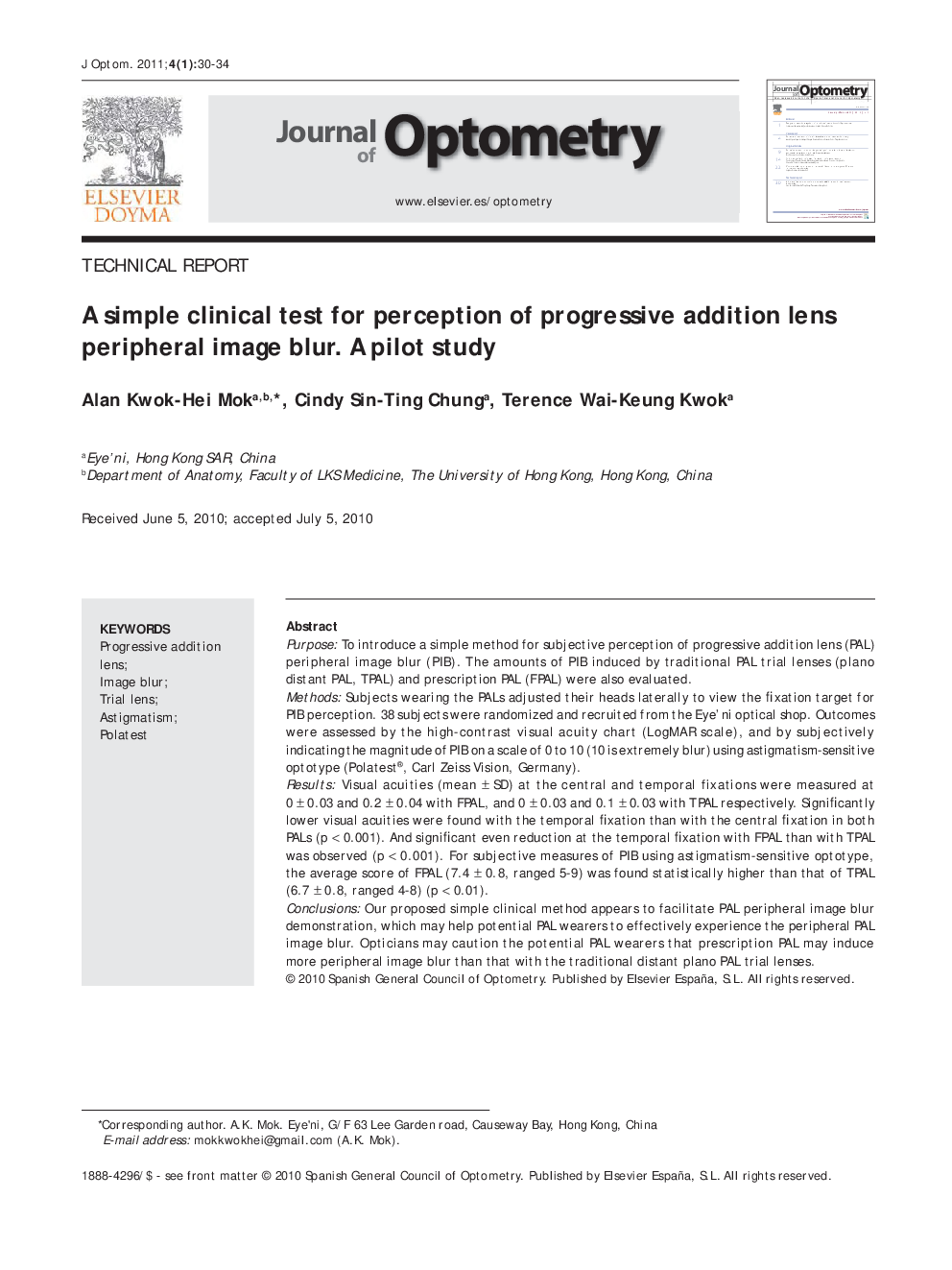| کد مقاله | کد نشریه | سال انتشار | مقاله انگلیسی | نسخه تمام متن |
|---|---|---|---|---|
| 2698709 | 1144055 | 2011 | 5 صفحه PDF | دانلود رایگان |

PurposeTo introduce a simple method for subjective perception of progressive addition lens (PAL) peripheral image blur (PIB). The amounts of PIB induced by traditional PAL trial lenses (plano distant PAL, TPAL) and prescription PAL (FPAL) were also evaluated.MethodsSubjects wearing the PALs adjusted their heads laterally to view the fixation target for PIB perception. 38 subjects were randomized and recruited from the Eye’ni optical shop. Outcomes were assessed by the high-contrast visual acuity chart (LogMAR scale), and by subjectively indicating the magnitude of PIB on a scale of 0 to 10 (10 is extremely blur) using astigmatism-sensitive optotype (Polatest®, Carl Zeiss Vision, Germany).ResultsVisual acuities (mean ± SD) at the central and temporal fixations were measured at 0 ± 0.03 and 0.2 ± 0.04 with FPAL, and 0 ± 0.03 and 0.1 ± 0.03 with TPAL respectively. Significantly lower visual acuities were found with the temporal fixation than with the central fixation in both PALs (p < 0.001). And significant even reduction at the temporal fixation with FPAL than with TPAL was observed (p < 0.001). For subjective measures of PIB using astigmatism-sensitive optotype, the average score of FPAL (7.4 ± 0.8, ranged 5–9) was found statistically higher than that of TPAL (6.7 ± 0.8, ranged 4–8) (p < 0.01).ConclusionsOur proposed simple clinical method appears to facilitate PAL peripheral image blur demonstration, which may help potential PAL wearers to effectively experience the peripheral PAL image blur. Opticians may caution the potential PAL wearers that prescription PAL may induce more peripheral image blur than that with the traditional distant plano PAL trial lenses.
ResumenObjetivoPresentar un método simple para la percepción subjetiva del desenfoque periférico de la imagen (DPI) de las lentes de adición progresiva (LAP). También se evaluó la cantidad de DPI inducido por las lentes de prueba LAP tradicionales (LAP planas distantes, TPAL) y las LAP graduadas (FPAL).MétodosSujetos con LAP ajustaron la cabeza lateralmente para mirar el objeto de fijación con el fin de percibir el DPI. Se incluyeron y aleatorizaron 38 sujetos de la óptica Eye’ni. Los resultados se evaluaron mediante el gráfico de agudeza visual de alto contraste (escala LogMAR) e indicando de manera subjetiva la magnitud del DPI sobre una escala de 0 a 10 (10 equivalía a desenfoque extremo) utilizando un optotipo apto para determinar el astigmatismo (Polatest®, Carl Zeiss Vision, Alemania).ResultadosLas agudezas visuales (media ± DE) en las fijaciones central y temporal se midieron a 0,00 ± 0,03 y 0,20 ± 0,04 con FPAL, y a 0,00 ± 0,03 y 0,10 ± 0,03 con TPAL, respectivamente. En ambas LAP se observaron agudezas visuales significativamente inferiores con la fijación temporal que con la fijación central (p < 0,001). Asimismo, se observó una reducción significativa constante en la fijación temporal con FPAL en comparación con TPAL (p < 0,001). Para las mediciones subjetivas del DPI utilizando un optotipo apto para determinar el astigmatismo, la puntuación media de la FPAL (7,4 ± 0,8; intervalo, 5–9) fue estadísticamente mayor que la de la TPAL (6,7 ± 0,8; intervalo, 4–8) (p < 0,01).ConclusionesAparentemente, nuestra propuesta de método clínico simple facilita la demostración del desenfoque periférico de la imagen de las LAP, lo que podría ayudar a posibles candidatos para LAP a experimentar de manera eficaz el desenfoque periférico de la imagen de LAP. Los ópticos pueden advertir a los posibles usuarios de LAP que las LAP graduadas pueden inducir más desenfoque periférico de la imagen que las lentes de prueba LAP planas distantes tradicionales.
Journal: Journal of Optometry - Volume 4, Issue 1, January–March 2011, Pages 30–34